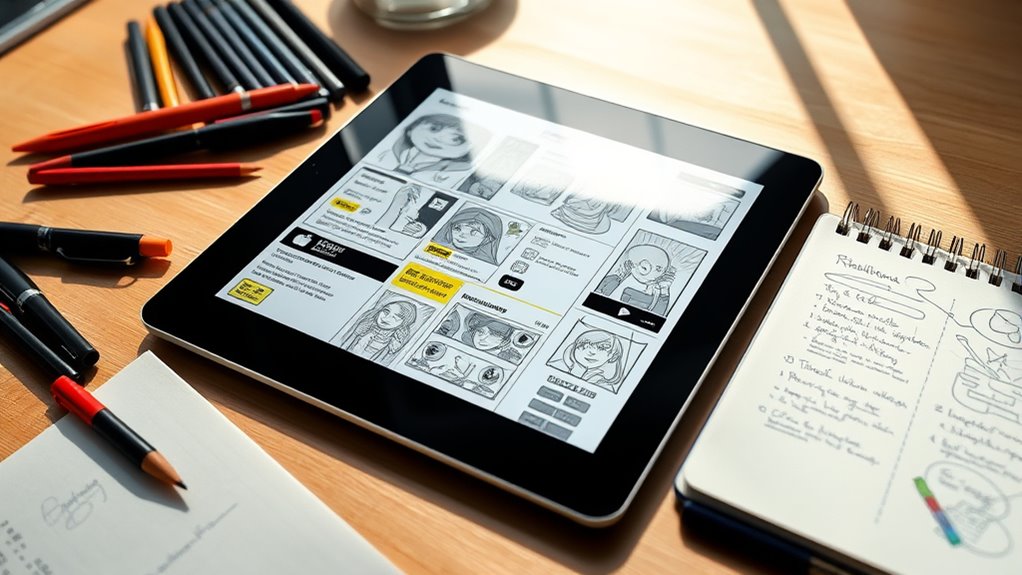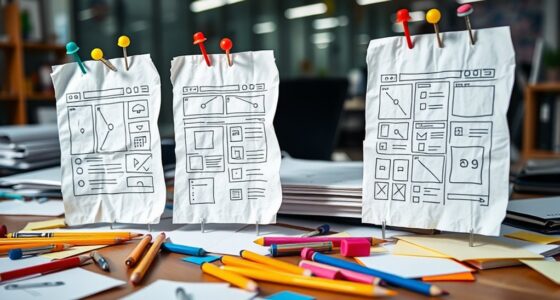Prototyping services with storyboards and visual scripts help you create clear, engaging user experiences by mapping interactions visually. These tools streamline communication, highlight potential challenges early, and foster collaboration among team members and stakeholders. They make complex ideas understandable and allow quick iterations for refinement. Incorporating storytelling techniques enhances emotional engagement and clarifies your prototypes. Keep exploring how these approaches can elevate your projects for more efficient, user-centered results.
Key Takeaways
- Utilize storyboards and visual scripts to clearly communicate prototypes, enhancing understanding and collaboration during experiments.
- Incorporate visual storytelling to simulate user interactions and identify potential issues early in the prototyping process.
- Use visual scripts to streamline prototype development, ensuring focus and efficiency in testing different scenarios.
- Leverage storyboards to evoke emotional engagement, making experimental prototypes more relatable and impactful.
- Share visual scripts with stakeholders for feedback, aligning expectations and refining prototypes through iterative visual experimentation.
The Role of Storyboarding in Modern Prototyping

Storyboarding plays an essential role in modern prototyping by providing a visual roadmap of user interactions and workflows. It leverages visual storytelling to communicate complex ideas quickly and clearly, making it easier for you to understand user journeys. The advantages of storyboards include highlighting potential pain points, streamlining design decisions, and fostering collaboration among team members. By creating a sequence of sketches or images, you can see how users will navigate your product, identify areas for improvement, and test different scenarios early in the development process. This visual approach simplifies communication across departments, saving time and resources. Incorporating natural elements into your storyboards can also promote a sense of tranquility and enhance creative thinking. Ultimately, storyboarding transforms abstract concepts into tangible visuals, ensuring your prototype aligns with user needs and expectations.
Benefits of Visual Scripts for User-Centered Design

Visual scripts serve as a powerful tool in user-centered design by translating complex user interactions into clear, easy-to-understand visuals. They help you communicate ideas effectively, fostering emotional engagement by making user experiences more relatable and memorable. By visualizing user journeys, you can identify pain points and opportunities for improvement more intuitively. Additionally, visual scripts encourage creative expression, allowing you to experiment with different scenarios, styles, and flows without heavy technical effort. This flexibility helps you better understand user needs and preferences, leading to designs that resonate on an emotional level. Furthermore, incorporating textile art techniques into your visual scripts can enhance their visual appeal and storytelling power. Overall, using visual scripts enhances collaboration among team members, streamlines feedback, and ensures your final product aligns closely with user expectations.
Crafting Effective Storyboards for Your Projects

To create impactful storyboards, focus on developing clear visual narratives that convey your ideas effectively. Keep your scenarios focused and relevant to guarantee your team stays aligned on project goals. Remember, a well-crafted storyboard guides everyone through the user journey with clarity and purpose. Incorporating visual storytelling techniques can further enhance comprehension and engagement throughout your project.
Clear Visual Narratives
Creating a clear visual narrative is essential for translating your ideas into a compelling story. Your storyboard should simplify complex, abstract concepts into visual sequences that are easy to follow. Focus on clarity by using straightforward visuals that convey the core message without confusion. Incorporate emotional storytelling to engage your audience and make your message memorable. Use consistent imagery and logical progression to guide viewers smoothly through the narrative. Avoid clutter and unnecessary details that distract from the main idea. Instead, highlight key moments that evoke emotion or clarify abstract ideas. A well-crafted visual story will not only communicate your project’s purpose but also foster understanding and connection with your audience, making your prototypes more impactful and persuasive. Cookies are also used to enhance user experience and personalize content, further supporting effective storytelling.
Focused Scenario Design
Focused scenario design is essential for crafting storyboards that effectively communicate your project’s purpose and guide your development process. By honing in on specific user interactions, you guarantee your storyboards reflect authentic experiences rooted in cultural insights. This focus helps you capture emotional resonance, making your scenarios more relatable and impactful. When designing these scenarios, consider the diverse backgrounds of your audience to avoid cultural blind spots. Clear, targeted scenarios enable you to identify key emotional triggers and user motivations, which improve the overall effectiveness of your prototype. Remember, a well-focused scenario guides stakeholders and developers alike, fostering a shared understanding that aligns with real-world behaviors and cultural nuances. This approach ultimately leads to more meaningful, user-centered prototypes. Additionally, understanding the legal process of divorce can inform how you design scenarios involving sensitive topics, ensuring your prototypes are respectful and accurate representations of real-life situations.
Integrating Storyboards Into the Prototyping Process

Integrating storyboards into your prototyping process streamlines visual planning and helps clarify your ideas from the start. It enables you to identify potential issues early, saving time and effort down the line. When you incorporate storyboards seamlessly, your workflow becomes more efficient and focused. Additionally, using visual scripts can enhance understanding of user interactions, similar to how animated movies touch hearts by conveying emotions effectively.
Visual Planning Benefits
When you incorporate storyboards into the prototyping process, you gain a clear visual roadmap that facilitates better communication and understanding among team members. This visual planning enhances emotional connection by allowing everyone to see and feel the user journey, fostering empathy. It also opens space for artistic expression, enabling you to creatively explore different scenarios and design ideas before development begins. Storyboards make complex concepts easier to grasp, reducing misunderstandings and aligning your team’s vision. By visually mapping interactions and flows, you can identify potential issues early, saving time and effort. Incorporating remote hackathons can further expand diverse perspectives and foster collaborative innovation across distances. Overall, this approach strengthens collaboration, sparks creative thinking, and ensures your prototype resonates emotionally with users, making your design process more effective and engaging.
Seamless Workflow Integration
To guarantee storyboards enhance your prototyping workflow, you need to seamlessly embed them into each phase of the process. This integration helps you avoid common storyboarding pitfalls that can cause workflow bottlenecks. Start by aligning storyboards with your project goals, ensuring they complement design and development stages. Use them as a communication tool to clarify user interactions early, preventing misunderstandings later. Keep updates consistent to avoid outdated visuals that slow progress. Avoid overcomplicating storyboards, which can create unnecessary delays and confusion. When integrated smoothly, storyboards become a dynamic part of your workflow, streamlining transitions between phases and fostering collaboration. Additionally, understanding the operating hours of related entertainment venues can help you plan your prototyping sessions around peak times, ensuring minimal interruptions and maximum productivity. This approach ensures your prototypes develop efficiently, with clear visual scripts guiding the entire process without disrupting momentum.
Tools and Techniques for Creating Impactful Storyboards

Creating impactful storyboards requires choosing the right tools and techniques that bring your ideas to life clearly and effectively. Start by selecting software or physical tools that suit your workflow, enabling easy editing and collaboration. Use cohesive color palettes to convey mood, highlight key actions, and maintain visual consistency throughout your storyboard. Incorporate animation techniques like simple motion or progressions to demonstrate flow and timing, making scenes more engaging and understandable. Focus on clear framing, perspective, and visual hierarchy to guide viewers’ attention. Remember, the goal is to communicate your concept efficiently; the right tools and techniques help you craft compelling, easy-to-follow storyboards that clearly represent your vision. Utilizing aesthetic wall organization can also help you visualize and plan your scene arrangements for better clarity.
Using Storyboards to Identify Potential Challenges Early

Using storyboards to identify potential challenges early allows you to visualize the entire user experience and spot issues before development begins. This step enhances your creative process by revealing pain points, confusing interactions, or overlooked needs. As you map out each scene, you gain a clearer understanding of how users will navigate your service, making it easier to anticipate obstacles. Early detection of these challenges saves time and resources, preventing costly revisions later. By focusing on the user journey through visual scripts, you can fine-tune the experience and ensure it aligns with user expectations. Incorporating design principles into your storyboard review process further improves accuracy and effectiveness. This proactive approach helps you build a smoother, more intuitive experience, ultimately increasing the likelihood of user satisfaction and successful implementation.
Iterating Quickly With Visual Scripts

Once you have your storyboards in place, you can rapidly iterate on your design by tweaking visual scripts to test different ideas and solutions. This process allows you to refine emotional storytelling by adjusting scenes, pacing, and visual cues. Use color symbolism strategically—changing hues can evoke specific emotions or highlight shifts in user experience. For example, warm colors might convey comfort, while cool tones evoke calmness. By experimenting with these visual elements, you quickly identify what resonates most with your audience. Small adjustments in your scripts help you gauge emotional impact, ensuring your prototypes effectively communicate your intended message. This iterative approach saves time, sharpens your narrative, and enhances the overall clarity of your prototype.
Collaborating and Communicating With Stakeholders Through Storytelling

After refining your visual scripts through quick iterations, the next step is to share these storyboards with stakeholders to gather feedback and align expectations. Use emotional storytelling to make your prototypes compelling, helping stakeholders connect with the user experience on a deeper level. This approach fosters stakeholder engagement by making the narrative relatable and memorable. Clearly communicate how the storyboard addresses user needs and project goals, encouraging active discussion. By emphasizing emotion and storytelling, you transform abstract ideas into tangible visions, making it easier for stakeholders to understand and support your experiments. Effective communication through storytelling builds trust, ensures everyone’s on the same page, and sets a solid foundation for successful prototypes.
Case Studies: Successful Experiments Driven by Storyboard Prototypes

Have you ever wondered how storyboard prototypes can directly lead to successful innovation? These case studies show that they can, when used effectively. One project avoided common storyboard pitfalls by focusing on clear visual storytelling, rather than relying on overly complex or vague images. By testing early concepts through storyboards, teams identified potential issues before developing costly prototypes. These experiments debunked visual storytelling myths, proving that simplicity often drives better understanding and engagement. For example, a startup refined its user flow based on storyboard feedback, boosting user satisfaction. The key is to keep storyboards realistic and focused on specific goals. When executed thoughtfully, storyboards become powerful tools for guiding innovation, reducing risks, and facilitating stakeholder buy-in.
Frequently Asked Questions
How Do Storyboards Differ From Traditional Wireframes in Prototyping?
Storyboards differ from traditional wireframes because they focus on visual storytelling, illustrating the user journey step-by-step. While wireframes show layout and functionality, storyboards emphasize user interactions and emotions, helping you map out experiences more holistically. This approach makes it easier to identify pain points and refine the overall UX. By combining storyboards with user journey mapping, you create a vivid, engaging prototype that guides design decisions effectively.
What Are Common Pitfalls to Avoid When Creating Storyboards?
Ever wonder what pitfalls could ruin your storyboard? You might overlook visual consistency, making your story confusing or disjointed. Don’t forget stakeholder engagement—ignoring feedback can lead to misaligned expectations. Avoid overly complex scenes that stall progress and neglect clear narration, which leaves viewers lost. Keep your story focused, simple, and visually coherent to guarantee your storyboard effectively guides your experiment and keeps everyone engaged throughout the process.
Can Storyboards Be Used for Non-Digital Products or Services?
Yes, storyboards can be used for non-digital products or services. You can create storyboards to map out the service journey or design physical mockups, helping you visualize customer interactions and experiences. This approach allows you to identify potential issues, refine the service flow, and communicate ideas clearly, whether you’re working on a physical product or a service. Storyboards are versatile tools for planning and testing various types of projects.
How Do Storyboards Influence User Experience Testing Outcomes?
Imagine you’re in the dark ages of user testing, but storyboards shine a light. They influence your outcomes by enhancing visual storytelling, which clarifies user journeys and highlights pain points. This boosts emotional engagement, making users more likely to connect and provide honest feedback. As a result, your testing becomes more insightful, helping you refine designs efficiently and create products that truly resonate with your audience.
What Are Cost-Effective Methods for Startups to Implement Storyboard Prototyping?
You want to implement storyboard prototyping cost-effectively, so start with affordable tools like Canva or Figma that offer templates and easy drag-and-drop features. Use DIY techniques, such as sketching scenes on paper or digital apps, to save costs. Focus on clear storytelling and user flow, which helps identify issues early without expensive software or professional services. This approach keeps your startup lean while improving your prototypes efficiently.
Conclusion
Think of storyboards as your guiding map through the creative landscape. Just like a navigator avoids dead ends and finds the fastest route, your visual scripts help you spot challenges early and refine your ideas quickly. When you embrace storyboarding, you’re not just sketching scenes—you’re charting a clear course to successful prototypes. With each iteration, you’re steering closer to your goal, turning rough drafts into seamless experiences that resonate with users.









